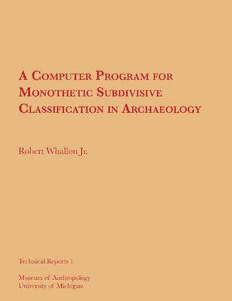Table Of ContentMUSEUM OF ANTHROPOLOGY, THE UNIVERSITY OF MICHIGAN
TECHNICAL REPORTS
Number 1
CONTRIBUTIONS IN COMPUTER APPLICATIONS TO ARCHAEOLOGY
Contribution 1
A COMPUTER PROGRAM FOR
MONOTHETIC SUBDIVISIVE CLASSIFICATION IN ARCHAEOLOGY
BY
ROBERT WHALLON, JR.
ANN ARBOR
1971
/
© 1971 by the Regents of the University of Michigan
The Museum of Anthropology
All rights reserved
ISBN (print): 978-1-949098-48-8
ISBN (ebook): 978-1-951538-46-0
Browse all of our books at sites.lsa.umich.edu/archaeology-books.
Order our books from the University of Michigan Press at www.press.umich.edu.
For permissions, questions, or manuscript queries, contact Museum publications by
email at umma-pubs@umich.edu or visit the Museum website at
lsa.umich.edu/ummaa.
A COMPUTER PROGRAM FOR
MONOTHETIC SUBDIVISIVE CLASSIFICATION IN ARCHAEOLOGY
ACKNOHLEDGEl>JE:NTS
All of the computer time and services necessary for the development
and testing of this program was provided me by the College of Literature,
Science and the Arts. Without this generous provision of computing
facilities, the development of the program would not have been possible.
I would like to thank also Roy Coppman and Les 14cCaughlin for their
help in vTri ting a large part of the first version of this program.
INTRODUCTION:
This report contains a brief description, operating instruction,
and a source listing of a computer program for monothetic subdivisive
classification in archaeology. This program was written at the Uni
versity of Michigan Museum of Anthropology and is in current use there.
The method of monothetic subdivisive classification was developed
in the field of plant ecology (Williams and Lambert, 1959, 1960; Lance
and Williams, 1965). Recent research has shoivn that this approach to
classification is of considerable value and interest in archaeology
(Whallon, n.d.). It has been extensively applied in problems of pottery
and also in the analysis of burials and the classification of
t~~ology
areas within archaeological sites. In all of these areas,
funct~onal
monothetic subdivision appears to offer some considerable advantages over
other methods of numerical taxonomy, the most common of which are agglo
merative and polythetic.
METHODS OF NUMERICAL CLASSIFICATION:
Monothetic methods of classification use only a single attribute to
determine membership of an item in one or another subgroup of a typology.
Polythetic methods take all attributes at once and use an index of
similarity or distance based on this simultaneous consideration of all
attributes. Classifications may be developed either by agglomeration,
grouping individuals into larger and larger groups until all individuals
are included in a single group, or by subdivision, dividing the population
into smaller and smaller subgroups until the classification is considered
complete by some criterion.
- 2 -
Monothetic agg.lomerative methods are obviously trivial. Classifi
cation is always completed in extremely few steps. Polythetic subdivisive
methods are computationally very complex and exceedingly time-consuming.
This leaves polythetic agglomerative and monothetic subdivisive approaches
as the two practicable methods of numerical classification. A more
complete discussion of these methods may be found in Williams and Dale
(1965).
Polythetic agglomerative methods of classification have recently
begun to be applied to archaeological data (Hodson, Sneath and Doran,
1966; Hodson, 1969). These methods ha,re been widely hailed as a solution
to the problem of finding an objective and replicable method for typology
in archaeology (e.g. Clarke 1968:512-47). Such methods would supposedly
eliminate subjective classification and replace the earlier, imperfect
statistical approaches to typology (e.g. Spaulding 1953, 1960; Sackett,
1966).
Numerical taxonomy of the polythetic agglomerative sort has had some
success in the analysis of archaeological data; in some instances, cer
tainly more so than the earlier statistical methods. In other instances,
however, it has not been so successful, and there are some :practical
problems in its general application.
NUMERICAL CLASSIFICATION IN ARCHAEOLOGY:
The logical bases for the application of various statistical methods
of classification were therefore examined in the course of working with
Late Woodland ceramics from New York state. Our aim was to find a
statistical approach which would come close to reduplicating the traditional
- 3 -
typology of these materials. Seriation of assemblages in which the
pottery had been classified in this traditional manner had proved to be
a reliable way of disclosing temporal, and to a lesser extent areal,
relations between sites. This must be remembered in evaluating the
following considerations. It is entirely possible that for other sorts
of data or for typologies intended to reveal other kinds of variability
these considerations may not be relevant. I think, however, that they
are probably of quite general validity and applicability. This is
discussed in more detail elsewhere (Whallon, n.d.).
The careful examination of the logic of statistical typology and of
the implicit logic of traditional typology shed light on three factors
which seem to indicate that polythetic agglomerative taxonomy is not a
particularly appropriate method for classifying archaeological materials.
Monothetic subdivisive analysis seems in this light to be more applicable.
The first two factors are the principles of shifting criteria and
of a hierarchy of importance of criteria for classification. These two
principles are crucial to the creation and use of most, if not all,
archaeological typologies. They are generally implicit, however, and
are, in fact, incongruent with the most common explicitly stated view
that types consist of recurring combinations of attributes which can be
shown to have historical or spatial meaning (Krieger, 1944).
Shifting Criteria
The of shifting criteria states that the specific
principl~
attributes, and even the general classes of attributes, which are
considered relevant for type definition change from one type to the next.

